This is Puleng, one of my former students in Lesotho. I learned to wash by hand from her and other students at Ngoana Jesu Secondary School, and I also learned from them to reuse my laundry water on my vegetable plots. I adopted that practice in Lesotho, and I’ve been trying to adapt it to my new context in Southern California.
Here I use a machine to do the washing, and I reuse the laundry water by directing it through a hose to a Chinese pistache tree.
But in getting from the Lesotho method to this California method, I made a few mistakes along the way.
When we moved into our house — almost two years ago, now — I disconnected the hose behind the washer so that instead of emptying into the sewer line I could empty it into a trash can. I then used a bucket to distribute that water to our burgeoning vegetable garden. It took a lot of time to distribute that water, however. The washing machine used more than three times as much (each load used between 15 and 30 gallons whereas in Lesotho each load used between 4 and 7 gallons).
So last spring I bought an extension for the machine’s plastic hose. I planted tomatoes, squashes, and melons in four groups along the driveway, fairly close to the washing machine, and I placed the end of the hose near one of the groups of plants each time we did a load. The plan was to water all of those plants with laundry water alone. Then the plants started dying. The young squash plants started showing symptoms first. The margins of their leaves looked burnt, and the plants grew very slowly in general. Next the tomatoes demonstrated toxicity. They screamed toxicity! Their leaves yellowed, purpled, curled, they stopped setting fruit, and so I yanked them out of the ground.
We had already switched to using the least toxic detergent we could find (Ecos brand), so then we cut back on the amount of that detergent we were using. It was all too late. The soil had been spoiled and the plants were goners.
I thought about why these vegetables were killed by my laundry water while my vegetables in Lesotho had thrived under an apparently similar regimen. Turns out they weren’t similar regimens.
In Lesotho, I often dumped the wash water in the bushes and only the rinse water on my vegetable plots. Yet here in California I was dumping both, so it added potentially harmful chemicals in higher concentrations. But more than that, I hadn’t used as much detergent in Lesotho in the first place. When washing by hand, you see how soiled each article of clothing is and you only apply as much detergent as is absolutely necessary. Having to work with your hands in such a detergent solution encourages you to use as little as possible because the skin on your fingers and palms get tight and painful if you use a lot. Now using the machine, we were just unthinkingly following the recommendation of the detergent manufacturer (“fill to this line”) and thereby adding much more detergent than we had while washing by hand in Lesotho — this even though the Ecos brand ingredients were much less toxic than the ingredients of the Surf brand that we used in Lesotho.
Another difference that occurred to me was that in Lesotho it rained all summer. There were thunderstorms which consistently leached the laundry water through the soil profile. In addition to that, when the rains failed, I watered my vegetables with collected rain off my roof and the school buildings’ roofs, as well as groundwater from a borehole pump. Yet here I was in California giving my vegetables a steady diet of nothing but laundry water.
Therefore, we come to our current method of reusing laundry water in the yard in Southern California.
For almost a year now, I have experienced excellent results by connecting a short extension hose (15 feet long) to the washing machine and snaking it under the Chinese pistache tree behind the garage. This tree receives additional rainwater all winter from the runoff from the nearby concrete porch as well as two roof downspouts, and thus the soil gets a leaching similar to what my Lesotho soil received. We place the hose near the spots where the porch and downspouts concentrate their rain runoff.
Whatever chemicals build up over the summer from laundry water (sodium is the particular chemical in Ecos detergent that I’m worried about) will be leached by the rinsing of clean rainwater through the winter. That’s the theory, anyway. So far it seems to be working out based on the fine appearance and new growth of the tree.
After we’ve finished with each laundry load, we hang the hose extension on the wall so it drains completely. This ensures that there is never any bad smell — for even a little laundry water sitting in a pipe will start to stink.
Why haven’t I installed permanent piping to direct the laundry water to the pistache tree? Seems like that would save the time of having to connect the flexible hose before each load and then having to hang it back up afterward. True, it would save that time, but that time adds up to literally five seconds. The task is so quick and not annoying that we don’t even think about it anymore.
But more importantly, there is only a single inch of fall between the level of the concrete porch and the soil surface beneath the pistache tree. Therefore, pipes would have to open into holes dug deep enough such that the pipes are sloped enough to drain completely. These holes would need to be maintained so they don’t clog the pipe outlets.
The permanent system would save the few seconds we spend connecting and disconnecting the flexible hose at the expense of the time and resources it would take to install (cut concrete, buy and lay pipe, dig outlet holes, etc.) plus maintain. As for now, the flexible hose method requires zero maintenance, has no chance of becoming clogged, and yet remains adaptable to additional plantings we might make in that part of the yard in the future.
Update 2022
Seven years later here, we continue with exactly the same routine and the Chinese pistache tree continues to grow wonderfully. Here it was ablaze in fall colors two years ago:
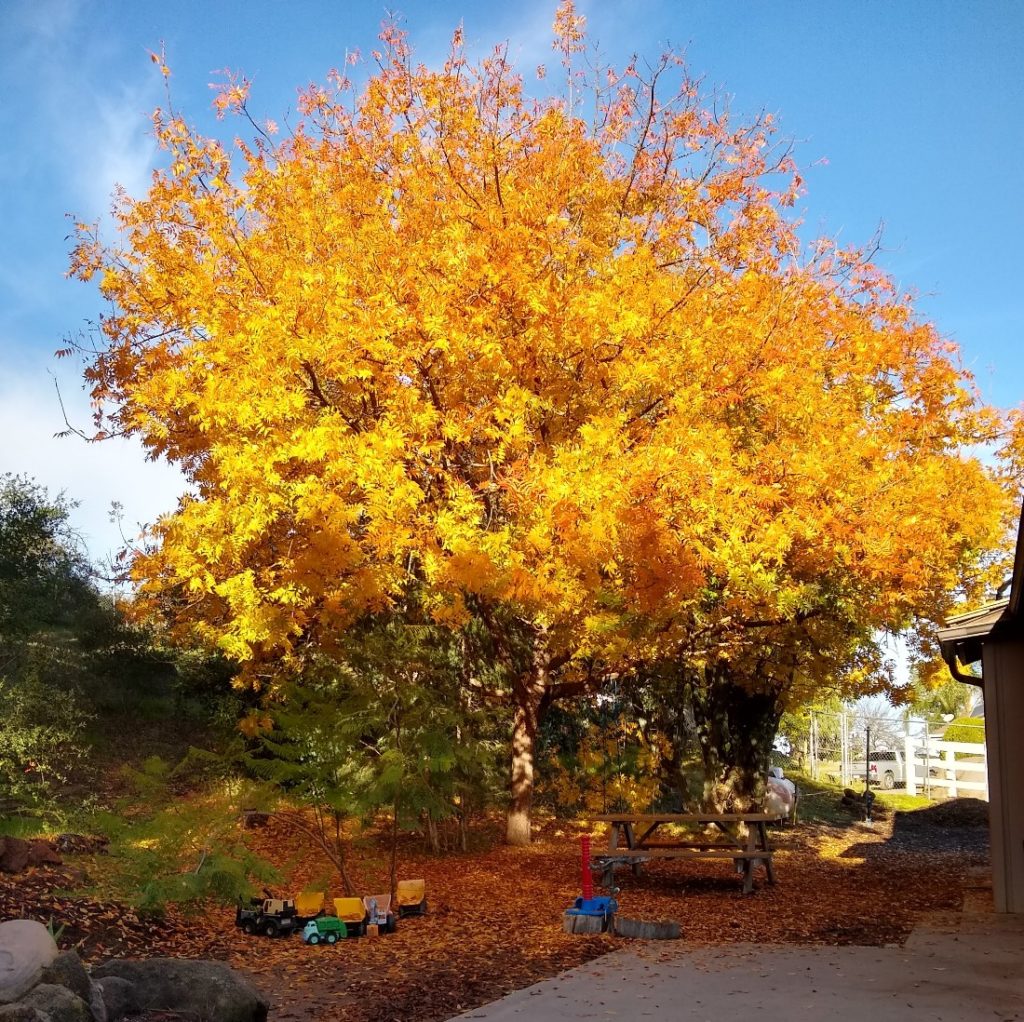
All of my Yard Posts are listed HERE

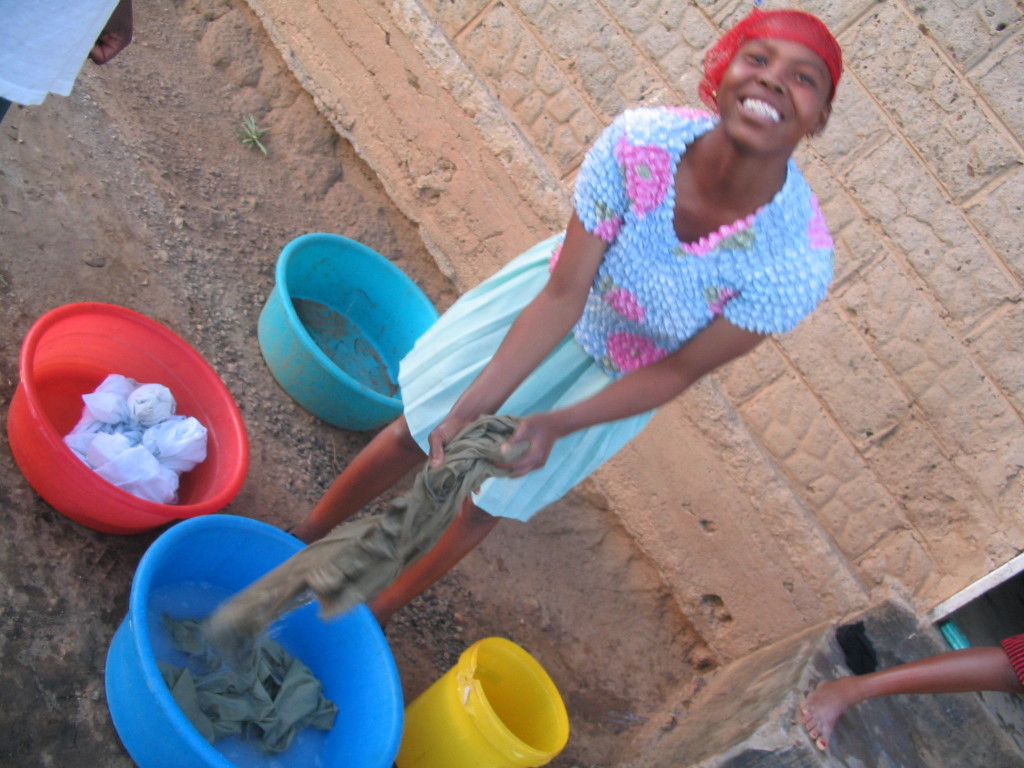
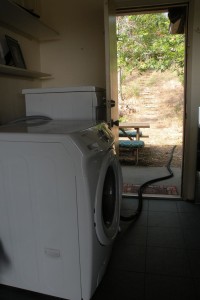
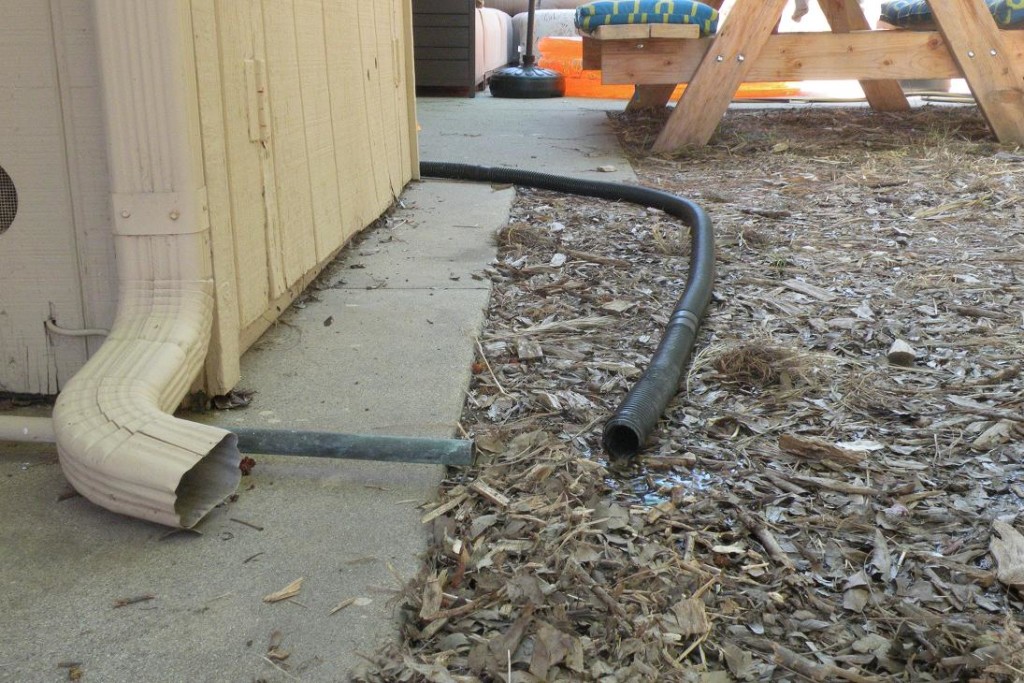
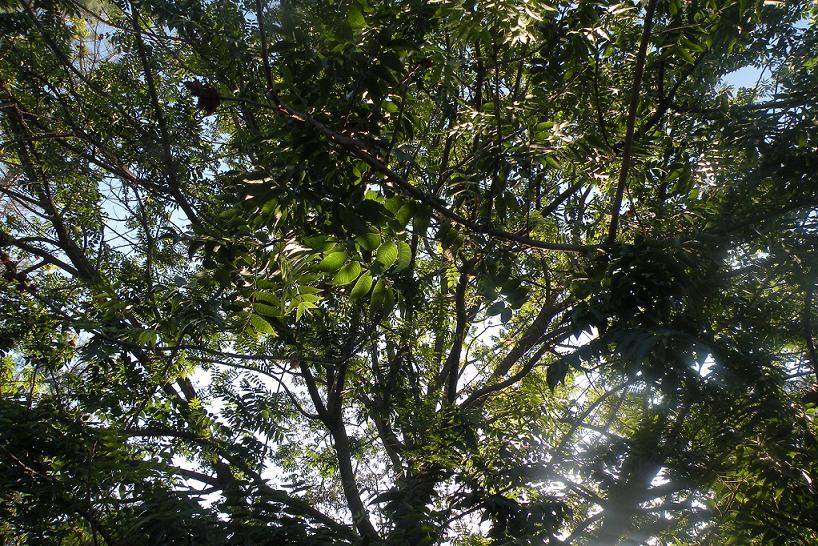
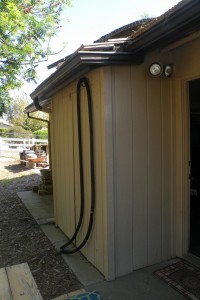


Do you think this would work on a patch of blueberries? Water them with laundry water during summer and wait for winter roof runoff to clear the salts? At my prior home, we used Oasis brand detergent which is supposedly the best for greywater use, and ran it to the lawn and olive tree. Never noticed an issue over 2 years, but never tried it on plants I really cared about.
Hi Laura,
I’ve never tried laundry water on blueberries although I do give mine other types of graywater. I suspect it will mostly depend on the detergent used, plus whether you try to grow the blueberries on laundry water only or just supplement your irrigation of the blueberries with laundry water. The poison is in the dose sometimes.
If I were trying it on blueberries, I’d use the laundry water just occasionally for the first couple years and then try switching over to only laundry water. If you try it, please let us know how it goes.
Hi Greg,
Last year I started using paper strips for laundry from a Canadian company TruEarth. They claim to be environmentally friendly. I haven’t tried watering my plants with the water yet, but I’m looking into using grey water for the garden.
These come in paper boxes, which means you don’t use plastic jugs and they can ship a lot more detergent with much less space! I’m not being paid for endorsing, but I’m happy to share this, if it means we can reduce plastic pollution.
And thanks for all your posts, as a fellow San Diegan home gardener, I find them very useful!
Thanks for sharing this, Svetlana. They list ingredients that are similar to those in the ECOS liquid detergent I’ve been using for the past handful of years. I wonder how easily you can use less than a full strip as they suggest. Can you just tear them in half? I’ve found that a load rarely needs as much detergent as manufacturers suggest. Less packaging would be a good thing.
Hi,
Just found a study from the Stellenbosch University about irrigating the garden with greywater.
https://www.sciencedirect.com/science/article/pii/S0022169421001062
They investigate the soil degrading effects of powder detergent and liquid detergent based greywater.
Vasco
Thanks for sharing this, Vasco. I used powdered detergent to wash my clothes in Lesotho, as did everyone else. Liquid detergent wasn’t available then.
Hi Greg,
About 2 years ago we designed and installed a 3-way watering system for the east side of our house in Ramona. It includes laundry gray water, rain water, and irrigation for a dwarf orange tree, a dwarf lemon tree, and a full size Desert Willow tree. The gray water parts cost about $75 and that has probably paid for itself by lowering our water bill. The gray water portion is gravity fed and ends about 2 ft below grade into 5 gallon buckets that are filled with 3/4″ gravel and have holes drilled for gradual drainage to the root systems of these 3 trees. This avoids odors and weeds. I couldn’t find an exact number but the average clothes washer of our style and vintage puts out about 25 gallons per load.
As a laundry cleaning agent, we switched to these laundry balls my brother found on line. These balls are softball size, very reasonable (~$8 for 2), and appear to be keeping our clothes clean. Still not sure how long they last but these are maybe 2 years old. If I have an exceptionally dirty load of clothes, I move my 3 way valve to dump to the sewer and use liquid laundry soap. In San Diego County, no permit is required for a laundry gray water system so I hope this information encourages others to consider saving water in this manner.
Hi Pete,
Thanks for sharing this. Do you also irrigate these trees in other ways or are they strictly dependent on the laundry water? How are they doing?
About how far from the trees’ trunks did you place the buckets?
What are those laundry balls called?
Hi Greg,
Sorry for the late reply, I missed your email in my Inbox. Yes, I have 3 means to irrigate these 3 trees. While we had a backhoe, we trenched so there is a feed from the rain gutters on that side of the house, irrigation on a timer, and the dirty laundry wash water. The trees are prospering, especially the Desert Willow, which is now about 8 ft H x 8 ft W and full of blossoms. I think we put those buckets about 1 ft away from the root ball.
This laundry ball looks similar, if not identical to what we’ve been using to clean our clothes and we’re pleased with the performance. Search for this product online: 2pcs Laundry Ball – Natural Non-Chemical Detergent Laundry Balls for Washing Machine – Eco Friendly.
I appreciate the effort you go to every week by publishing so many gardening tips! Many thanks for providing that service.
All the best,
Pete
I have been using laundry rinse cycle water only (not soapy) to water fruit and avocado trees and large shrubs for about 6 months. I have to set a timer to move the hose. My husband rigged up a tank on a cart with a pump. I cold water wash only because we have a water softener on the hot. ECOS liquid detergent. Extra dirty/stinky loads I wash in warm with Tide and don’t save the water. I don’t water vegetables with rinse water. So far everything seems healthy. There are 2 adults and 3 teenagers in my household so laundry day generates a LOT of water.
Anyone have experience with the detergent sheets or another brand?
Thanks for this, Laura. Hope things keep growing well.
Svetlana above said that she has been using paper strips from TruEarth, but she hasn’t used the water on her plants.
Looking at the ingredients list of the TruEarth sheets, they have more ingredients than ECOS and some of them I have never heard of. Just based on the ingredients list, I would go for ECOS over TruEarth.
TruEarth ingredients: https://www.tru.earth/Ingredients#fragrancefree
ECOS ingredients: https://www.ecos.com/product/detergents/hypoallergenic-laundry-detergent-free-clear/
From my research before we started grey watering was that only Oasis Biocompatible Laundry Detergent can be used for grey watering plants. It is designed and tested to be biocompatible with plants and soil, actually beneficial to the environment.
Hi Stacey,
I’ve never used Oasis so I have no firsthand experience to share although I’ve long heard of it and read about it in books by Art Ludwig. Do you use it? What have the results been?
The only part of the ingredients list for Oasis that jumps out at me is potassium chloride, which is not something our plants or soils need in Southern California, according to the soil scientists and fertilizer folks I’ve talked to. Avocados especially don’t want it. When fertilizing avocados, they recommend using potassium sulfate instead. We already have too much chloride in our irrigation water, usually (both from district and well sources). The good news is that avocados are the most sensitive to chloride so other plants are likely to suffer less.
Oasis ingredients list: https://www.bio-pac.com/oasis-biocompatible-cleaners/oasis-biocompatible-super-concentrated-laundry-liquid/
On the other hand, Oasis doesn’t have sodium. That’s good. In comparison, ECOS has sodium but doesn’t have chloride. Both sodium and chloride are not good additions, I’m told. Chloride is said to be worse, for avocados anyway.
I would love for someone to do an experiment using both of these detergents to see which is less toxic to a variety of plants and soils.
Thanks for this info Greg. Is there something we can add to the soil to offset the sodium and/or chloride?
Hi Lora,
You can leach to remove sodium and chloride (move it to lower soil depths), which means adding extra water that has lower sodium or chloride levels. People also add gypsum to reduce sodium (not chloride).